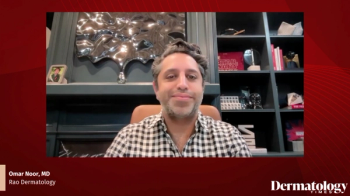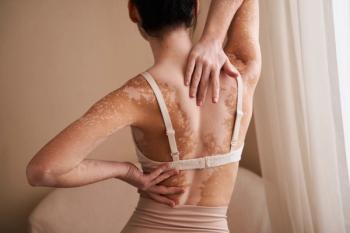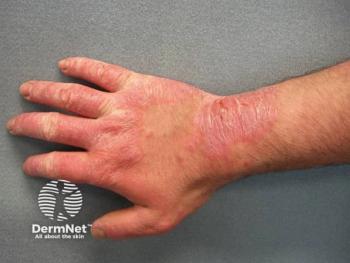
- Dermatology Times, August 2025 (Vol. 46. No. 08)
- Volume 46
- Issue 08
Real Cases Drive Honest Dialogue on Topicals for AD
Key Takeaways
- Novel topical agents like ruxolitinib, tapinarof, and roflumilast are being integrated into AD treatment, offering alternatives to corticosteroids and calcineurin inhibitors.
- The roundtable emphasized shared clinical reasoning, focusing on cases with refractory hand AD, facial AD in adolescents, and pediatric AD with sleep disruption.
Temitayo Ogunleye, MD, guided clinicians through diverse AD cases to examine how newer agents fit into evolving treatment strategies.
Atopic dermatitis (AD) is a common yet deeply complex inflammatory skin disease that often presents clinicians with significant therapeutic challenges. Despite well-established treatment algorithms, patients who fail first-line topical therapies frequently enter a gray zone where guidelines offer little clarity and practice-based knowledge becomes paramount. In this space, the Dermatology Times Case-Based Roundtable exclusive event sought to offer meaningful clinical insight.
The roundtable brought together clinicians in an intimate, discussion-driven forum focused on topical therapies beyond corticosteroids and calcineurin inhibitors. The roundtable’s moderator, Temitayo Ogunleye, MD, guided participants through 3 diverse AD cases, each exploring how novel topical agents like ruxolitinib, tapinarof, and roflumilast are being integrated into clinical care.
The session was not intended to sell a singular treatment approach. Instead, it created an environment for shared clinical reasoning, open exchange of successes and setbacks, and critical evaluation of newly emerging data. Attendees included clinicians from academic and private practice backgrounds, allowing for diverse perspectives and practice patterns.
Reconsidering the Role of Topicals
The roundtable centered on topical agents for AD that fall outside the long-standing default options: topical corticosteroids and calcineurin inhibitors. With the recent approval of nonsteroidal topicals that work via alternative mechanisms (eg, Janus kinase inhibition, aryl hydrocarbon receptor modulation, and PDE4 inhibition), clinicians now face the question of where these agents fit on the treatment ladder.
As Ogunleye summarized, “The concept was to evaluate newer topical therapies and their placement in managing AD, especially in patients who don’t respond to first-line treatments or for whom systemic therapy is not feasible or preferred.”
Case 1: Refractory Hand AD in a Nail Technician
The first case discussed was a woman with long-standing AD localized to the hands—a high-impact area given her occupation as a nail technician. Despite prior success with triamcinolone, she was now experiencing breakthrough flares, along with intense and disruptive pruritus. She had failed treatment with tacrolimus and expressed a desire to stay within topical therapy.
The group focused on itch—its severity and impact on quality of life. The discussion pivoted to topical ruxolitinib, which has been shown to provide rapid itch relief, with some studies demonstrating improvement within 15 minutes of application. One key takeaway was the importance of time to itch relief as a treatment outcome—not just clearance rates or lesion severity.
Case 2: Facial AD in a Teen With Systemic Therapy Hesitation
The second case featured a 15-year-old girl with facial and neck involvement, areas known for both visibility and sensitivity. She had previously tried corticosteroids, tacrolimus, and crisaborole, which she discontinued due to burning on application. Though dupilumab was discussed, the patient declined systemic therapy, requiring a renewed look at topical options.
The roundtable examined the role of tapinarof, which is approved for patients 2 years and older and has a cream formulation amenable to facial use. Its nonsteroidal profile and favorable vehicle characteristics made it a reasonable option, especially for facial involvement where greasy formulations or those associated with acneiform eruptions may be less desirable.
This case highlighted 2 practical considerations: the role of patient preference—particularly in adolescent populations—and formulation considerations when treating visible or sensitive areas.
Case 3: Pediatric AD With Sleep Disruption
The final case involved a 9-year-old boy with classic flexural AD, significant itch, and sleep disturbance. Despite trials of topical corticosteroids, tacrolimus, and oral antihistamines, he remained symptomatic. Systemic therapy was ruled out by parental choice, placing clinicians in a therapeutic bind.
Discussion turned again to ruxolitinib, particularly unpublished data on its use in children younger than 12 years. The group reviewed early findings suggesting efficacy in pediatric patients aged 3 to 11 years, mirroring results seen in adults. Though the drug is not FDA approved for this age group, attendees expressed interest in the data and hope for future pediatric indication.
One important nuance raised was the variability in access to newer agents. Private practice clinicians reported better success securing coverage and providing samples, while those in academic settings—especially those with strict pharmaceutical access policies—described more hurdles. This led to a broader conversation about equity of access and the growing importance of formulary navigation in treatment planning.
Conclusion
Participants described the roundtable format as more than just a clinical review; it was an opportunity to better understand how other clinicians apply evidence in a practical setting. Ogunleye emphasized the value of a balanced discussion that spanned multiple treatment approaches. Unlike traditional sessions focused on a single agent or mechanism, this roundtable allowed for cross-comparison, which fostered more nuanced clinical judgments.
The roundtable proved to be a clinically meaningful event that addressed a real need: helping clinicians understand what’s new and how to use it. With the increasing complexity of treatment choices in AD—especially as nonsteroidal topicals enter the picture—forums like this are becoming more necessary.
Articles in this issue
3 months ago
Examining Bond-Building Hair Care Treatments4 months ago
Dermatology Times August 2025 Print RecapNewsletter
Like what you’re reading? Subscribe to Dermatology Times for weekly updates on therapies, innovations, and real-world practice tips.



















